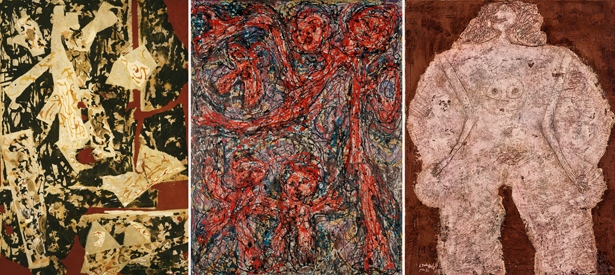Angels, Demons, and Savages: Pollock, Ossorio, Dubuffet
9 February–12 May 2013
The Phillips Collection
1600 21st Street, NW, Washington, D.C.
Dupont Circle Metro (Q Street exit)
Hours: Tuesday–Saturday 10–5pm; Sunday 11–6pm; Thursday extended hours: 5–8:30pm
Closed Mondays, Thanksgiving Day, Christmas Eve, Christmas Day, and New Year’s Day
T 202 387 2151
The Phillips Collection pulls back the curtain on American abstract expressionism to reveal a little-known but captivating story that focuses on the relationship between three of the movement’s seminal players: American painter Jackson Pollock (1912–1956), American artist and patron of abstract expressionism Alfonso Ossorio (1916–1990), and French painter Jean Dubuffet (1901–1985). Featuring 55 paintings and works on paper from 1945 to 1958, the exhibition illuminates a key moment in postwar art—one that was profoundly influenced by the artists’ transcontinental dialogue. It reunites a number of works by Pollock and Dubuffet from Ossorio’s collection for the first time since they were dispersed after his death in 1990.
Angels, Demons, and Savages diverges from the conventional history of American abstract expressionism to unravel a more nuanced narrative infused with artistic friendship and creative dialogue. The exhibition reveals visual affinities between the three artists’ work, tracing the impact of Dubuffet’s art brut (art by the mentally ill and other so-called outsiders), the experimental spirit of Pollock’s technique, and Ossorio’s figurative language. As the focal point of the art world shifted from Europe to America, the exchange between two of its leading protagonists—Jackson Pollock and Jean Dubuffet—and the less known but equally critical participant Alfonso Ossorio, helped bridge the ever-widening gap between the continents.
Alfonso Ossorio, who is virtually absent from standard art history texts, is the central figure in this story. One of the most colorful figures in postwar American art, his altruism as the heir to a vast Philippine sugar fortune has obscured his own work as a painter. From 1952 to 1962, Ossorio housed and exhibited at his East Hampton, New York, estate Dubuffet’s art brut collection. An artist and collector with a lively mind and entrepreneurial spirit, Ossorio amassed hundreds of works by Pollock and Dubuffet, including one of Pollock’s most celebrated paintings, Number 1, 1950 (Lavender Mist).
About the artists
Jackson Pollock, Alfonso Ossorio, and Jean Dubuffet were among a group of artists in the mid-1950s who sought a different pictorial language through innovative use of materials and techniques. While each was classically trained, they moved away from traditional painting methods that involved the application of paint using a brush to a canvas placed upright on an easel. Instead, these three artists developed techniques such as dripping, pouring, rubbing, and throwing their media onto paper, canvas, and hardboard panels placed on horizontal surfaces. Even in their simpler drawings and sketches, they adopted and combined domestic and imported papers with their mixed-media palette in novel ways. In their more ambitious works they incorporated a broad range of unorthodox materials, including enamel paint, wax, sand, pebbles, and tar, to create unusual surface textures.
Organization
The exhibition is co-organized by The Phillips Collection, Washington, D.C., and the Parrish Art Museum, Water Mill, New York, and is on view at the Parrish from July 21 through October 27, 2013. The lead curator for the exhibition is Klaus Ottmann, who worked closely with Phillips Director Dorothy Kosinski. The exhibition is made possible through support from the Terra Foundation for American Art. The exhibition in Washington is proudly sponsored by Lockheed Martin. Additional support is provided by the Dedalus Foundation, Inc.
Catalogue
The fully illustrated catalogue co-published by The Phillips Collection and Yale University Press features essays by Klaus Ottmann, Phillips curator at large and exhibition co-curator; and Alicia Longwell, the Lewis B. and Dorothy Cullman Chief Curator, Art and Education at the Parrish Art Museum. The catalogue also includes the first English translation of Dubuffet’s major essay on Ossorio and an in-depth study of the materials and techniques used in the works of the three artists, prepared collaboratively by Phillips Head of Conservation Elizabeth Steele and Paper Conservator Sylvia Albro with independent conservator Chantal Bernicky and Philadelphia Museum of Art conservator Scott Homolka.
*Images above: (left to right) Jackson Pollock, Collage and Oil, c. 1951. Oil, ink, gouache, and paper collage on canvas, 50 x 35 inches. The Phillips Collection, Washington, D.C. © 2012 The Pollock-Krasner Foundation / Artists Rights Society (ARS), New York; Alfonso Ossorio, Red Family, 1951. Oil and enamel on canvas, 77 x 59 inches. Dallas Museum of Art. General Acquisitions Fund and Theodore and Iva Hochstim Fund; Jean Dubuffet, Corps de dame—Château d’Étoupe (Body of a Lady—Stuffed Castle), 1950. Oil on canvas, 45 3/4 x 35 3/8 inches. Allen Memorial Art Museum, Oberlin College, Oberlin, Ohio. Gift of Joseph and Enid Bissett. © 2012 Artists Rights Society (ARS), New York / ADAGP, Paris.



